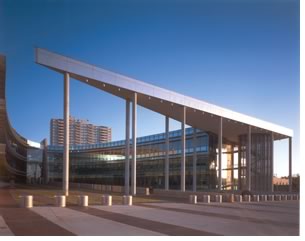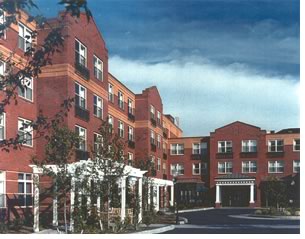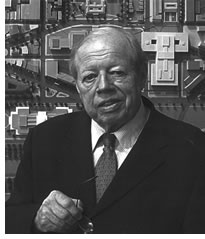

01/2005
Carol Ross Barney, FAIA, Chicago; Diane Georgopulos, AIA, Boston; and Charles Atherton, FAIA, Washington D.C., have been selected to receive the AIA 2005 Thomas Jefferson Award for Public Architecture. The Thomas Jefferson Award recognizes excellence in architectural advocacy and achievement in three categories:
- Private-sector
architects who have established a portfolio of accomplishment in the
design of architecturally distinguished public facilities
- Public-sector architects who manage or produce quality design within
their agencies
- Public officials or other individuals who by their role of advocacy have furthered the public’s awareness and/or appreciation of design excellence.
Category One: Private-sector architects
 Carol Ross Barney, FAIA
Carol Ross Barney, FAIA
Carol Ross Barney, FAIA, through her Chicago-based firm, Ross Barney
+ Jankowski, has enhanced the quality of public architecture, taking
it to new heights. As one of her nominators put it, her projects are “all
icons on shoestring budgets”—a marvelous accomplishment that
makes her worthy of this award in the eyes of the jury. Ross Barney’s
portfolio of public projects demonstrates a lasting legacy of excellence.
Her work has resulted in major improvements not only to the city and
suburbs of Chicago and the state of Illinois, but nationally as well.
The new Oklahoma City Federal Building, the first of its kind, demonstrates
how complex security requirements can be addressed in an unusually
creative and attractive manner.
 In addition to the Oklahoma City Federal Building, Ross Barney + Jankowski’s
long list of award-winning architecture includes the U.S. Post Office,
Glendale, Ill. (1991 AIA Honor Award); Cesar Chavez Elementary School,
Chicago (1994 AIA Honor Award for Architecture); and the Little Village
Academy, Chicago (2000 AIA Honor Award for Interior Architecture and
a 2002 AIA Honor Award for Architecture). The firm also has captured
numerous awards from AIA Chicago and local and state civic groups. Ross
Barney is noted for her professional and civic involvement in her community
as well, and in the aftermath of the September 11, 2001, terrorist attacks,
has served in many aspects as a security adviser.
In addition to the Oklahoma City Federal Building, Ross Barney + Jankowski’s
long list of award-winning architecture includes the U.S. Post Office,
Glendale, Ill. (1991 AIA Honor Award); Cesar Chavez Elementary School,
Chicago (1994 AIA Honor Award for Architecture); and the Little Village
Academy, Chicago (2000 AIA Honor Award for Interior Architecture and
a 2002 AIA Honor Award for Architecture). The firm also has captured
numerous awards from AIA Chicago and local and state civic groups. Ross
Barney is noted for her professional and civic involvement in her community
as well, and in the aftermath of the September 11, 2001, terrorist attacks,
has served in many aspects as a security adviser.
The jury noted that Ross Barney’s office offers an unusual reflection of society at large in that it is one of the most demographically diverse firms in the country. She has created a unique working environment where women, and persons of color especially, can thrive. Perhaps, the jury posited, the diversity of the firm helps explain how and why its work relates so well to the diverse populations of those who use its projects.
“Ross Barney’s architecture career demonstrates a strong sensitivity, care, and compassion for the public,” said the jury. “Her projects not only listen and respond to users’ needs, they also dignify users.”
Category Two: Public-sector architects
 Diane Georgopulos, AIA
Diane Georgopulos, AIA
As a design review architect for the past 18 years, Diane Georgopulos,
AIA, has evolved in her role at the Massachusetts Housing Finance Agency
(MassHousing), a public bank charged with the mission of building affordable
housing.
According to her nominators at the Boston Society of Architects, two programs exemplify her skills and adroitness at pursuing the public good.
The first, The Demonstration Disposition Program, a federal initiative that “can best be described as a complex blend of housing, economic development, and resident empowerment,” invested a $320 million budget by the U.S. Department of Housing and Urban Development, the largest ever given to the State of Massachusetts. Georgopulos coordinated the planning and design and/or renovation of some 1,850 units of rundown housing in 14 developments in three Boston neighborhoods—working with architecture firms and resident associations to cut through red tape.
 Her
second major undertaking, The Elder Choice Program, found Georgopulos
serving as the project’s design team member. She actively participated
in creating 1,500 units of housing for healthy seniors at a wide range
of income levels who might otherwise have been placed inappropriately
in nursing homes. Georgopulos was able to employ her user-based and behavior-based
design studies while a student at SUNY/Buffalo and MIT on this project. “Georgolpulos’ commitment,
dedication, and talent have been consistently applied to achieving successful
results,” wrote her nominators. “She has striven to advance
the quality of design in serving the higher purpose for eliminating blight
and improving the condition of those most in need of safe, decent, and
affordable housing.”
Her
second major undertaking, The Elder Choice Program, found Georgopulos
serving as the project’s design team member. She actively participated
in creating 1,500 units of housing for healthy seniors at a wide range
of income levels who might otherwise have been placed inappropriately
in nursing homes. Georgopulos was able to employ her user-based and behavior-based
design studies while a student at SUNY/Buffalo and MIT on this project. “Georgolpulos’ commitment,
dedication, and talent have been consistently applied to achieving successful
results,” wrote her nominators. “She has striven to advance
the quality of design in serving the higher purpose for eliminating blight
and improving the condition of those most in need of safe, decent, and
affordable housing.”
“Georgopulos’ career has been spent on developing methods that would enhance the ability of the public sector to implement government policy to bring life to decaying neighborhoods but doing it in a manner that has kept resident leaders involved,” said the jury. “She has developed innovative methods of creating affordable housing that have improved the quality of life for those most in need, without losing sight of the importance of good urban design in creating communities.”
Category Three: Public officials
 Charles H. Atherton, FAIA
Charles H. Atherton, FAIA
“Commitment to excellence in architecture,” the beginning treatise
of the Thomas Jefferson award, is epitomized by the work of Charles Atherton,
FAIA, who served 44 years as secretary of the Commission of Fine Arts. “Atherton’s
influence on works of public architecture and maintaining quality architecture
and planning in our nation’s capital is reminiscent of Mr. Jefferson’s
own commitment to the built environment,” according to the jury.
“His exceptional stewardship as secretary of the Commission is without equal in its profound influences on the nation’s capital,” wrote nominator Harry G. Robinson III, FAIA, dean emeritus and professor of urban design at Howard University and former chair of the U. S. Commission of Fine Arts. “A scholar on the development of the City, he brought reason and thoughtfulness to decisions affecting its memorials; changes in its landscape, structure, and patterns; and to its built interventions.”
 Atherton
devoted his professional career to carrying forth the commission’s
ideal of functioning as an independent agency to advise the federal and
District of Columbia governments on matters of art and architecture that
affect the appearance of the nation’s capital. Among the projects
on which he worked were the FDR Memorial, Lafayette Square directly opposite
the White House, and the WWII Memorial, which was 10 years in the making.
In fact, Atherton retired on May 24, 2004, the day the WWII Memorial
was dedicated.
Atherton
devoted his professional career to carrying forth the commission’s
ideal of functioning as an independent agency to advise the federal and
District of Columbia governments on matters of art and architecture that
affect the appearance of the nation’s capital. Among the projects
on which he worked were the FDR Memorial, Lafayette Square directly opposite
the White House, and the WWII Memorial, which was 10 years in the making.
In fact, Atherton retired on May 24, 2004, the day the WWII Memorial
was dedicated.
“Atherton’s influence in major decisions of design in Washington is enormous. Freedom Plaza, the preservation of the Willard Hotel, the Georgetown Waterfront, extension of the West Front of the Capitol—to name only a few—exhibit his lasting legacy and love for our nation’s capital,” said the jury. “His receipt of this award expresses not only his love of our nation’s capital, but his enduring affection for preservation and sustainability.”
This year’s award winners will receive their awards at the AIA national convention in Las Vegas in May.
Copyright 2005 The American Institute of Architects.
All rights reserved. Home Page ![]()
![]()
 |
||
AIA 2005
Thomas Jefferson Award for Public Architecture Jury
|
||